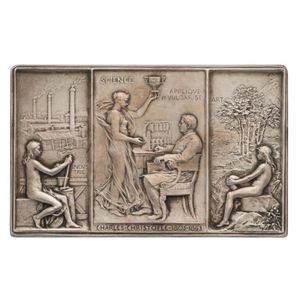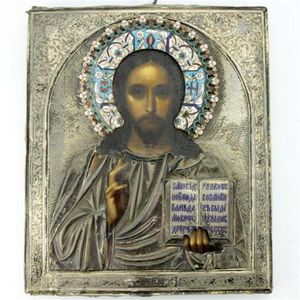Bronze Medallions and Plaques, Including London and Beethoven Profiles
You must be a subscriber, and be logged in to view price and dealer details.
Subscribe Now to view actual auction price for this item
When you subscribe, you have the option of setting the currency in which to display prices to $Au, $US, $NZ or Stg.
- Gilding - Gilding is a method of ornamentation whereby a thin sheet of gold metal is applied to items made of wood, leather, ceramics, glass and silver for decorative purposes.
For furniture including mirrors, the sheet of gold is usually applied over a coating of gesso. Gesso is a mixture of plaster of Paris and gypsum mixed with water and then applied to the carved wooden frames of mirrors and picture frames as a base for applying the gold leaf. After numerous coats of gesso have been applied, allowed to dry and then sanded a coat of "bole", a usually red coloured mixture of clay and glue is brushed on and allowed to dry, after which the gold leaf is applied. Over time parts of the gilding will rub off so the base colour can be seen. In water gilding, this was generally a blue colour, while in oil gilding, the under layer was often yellow. In Victorian times, gilders frequently used red as a pigment beneath the gold leaf.
Metal was often gilded by a process known as fire gilding. Gold mixed with mercury was applied and heated, causing the mercury to evaporate, the long-term effect of which was to kill or disable the craftsman or woman from mercury poisoning. The pursuit of beauty has claimed many victims, not the least of which were the artists who made those pieces so highly sought after today. - Bronze - An alloy of copper and tin, traditionally in the proportions of about 9 parts of copper to 1 part of tin.
The discovery of bronze in Western Asia in the 4th century enabled people to create metal objects which were superior to those previoulsy possible because of its strength and hardness, and it has been used throughout the world for weapons, coins, tools, statuary and other decorative items.
It is very fluid in a molten state, and its hardness, strength when set, and non-corrosive properties makes it most suitable for casting sculpture.
This item has been included into following indexes:
- paperweights, material
Visually similar items

A Russian Icon of Christ Pantocrator with embossed silver oklad, 19th century. The oklad struck with assayers marks and initials, 1861, together with a small wooden easel. 37 x 32 cm

Early Russian icon with silver plated oclad, Saint, with Cyrillic dedication to upper left and right. Silver plated oclad (worn), on board verso. 31 cm 23 cm

France: 1892, 50th Anniversary of the Christofle Company, silvered-bronze plaque by Oscar Roty, 95 x 59 mm; 129gms.

Russian silver 84 standard & enamel icon Christ Pantokrator modelled with mild colours, the raised border of the silver oklad tooled with stylized forms, with an enamel halo. Condition, good to fair, some wear consistant with age. Dimensions, 31.5 x 26.5 c
